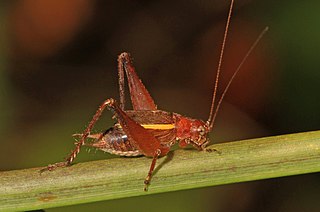
Insects in the family Tettigoniidae are commonly called katydids or bush crickets. They have previously been known as "long-horned grasshoppers". More than 8,000 species are known. Part of the suborder Ensifera, the Tettigoniidae are the only extant (living) family in the superfamily Tettigonioidea.

The bluish-grey saltator or Amazonian grey saltator is a passerine bird in the tanager family Thraupidae that is widespread in semi-open habitats in tropical and subtropical South America.

Entomophagy in humans or human entomophagy describes the consumption of insects (entomophagy) by humans in a cultural and biological context. The scientific term used in anthropology, cultural studies, biology and medicine is anthropo-entomophagy. Anthropo-entomophagy does not include the eating of arthropods other than insects such as arachnids and myriapods, which is defined as arachnophagy.

The buff-throated saltator is a seed-eating bird in the tanager family Thraupidae. It breeds from southeastern Mexico to western Ecuador and northeastern Brazil.

The black-headed saltator is a seed-eating bird in the tanager family Thraupidae. It breeds from central Mexico to eastern Panama.

Zapus is a genus of North American jumping mouse. It is the only genus whose members have the dental formula 1.0.1.31.0.0.3. Zapus are the only extant mammals aside from the Aye-aye with a total of 18 teeth.

The streaked saltator is a species of saltator in the family Thraupidae. It is found in Colombia, Costa Rica, Ecuador, Guadeloupe, Panama, Peru, and Venezuela.

Crickets are orthopteran insects which are related to bush crickets, and, more distantly, to grasshoppers. In older literature, such as Imms, "crickets" were placed at the family level, but contemporary authorities including Otte now place them in the superfamily Grylloidea. The word has been used in combination to describe more distantly related taxa in the suborder Ensifera, such as king crickets and mole crickets.

Oecanthus fultoni, also known as the snowy tree cricket, or thermometer cricket, is a species of tree cricket from North America. It feeds on leaves but also damages fruit. The chirp of this species is often dubbed onto sound tracks of films and television shows to depict a quiet summer's night. The rate of chirp varies depending on the heat of the environment, allowing a listener to estimate the temperature.

Hapithinae is a subfamily of insects in the cricket family Gryllidae. It is one of several groups referred to in American English as "bush crickets", although this term can be confused with the Tettigoniidae.
Pedetontus is a genus of jumping bristletails in the family Machilidae. There are about 10 described species in Pedetontus.

Hapithus agitator is a species of cricket in the genus Hapithus, in the subfamily Hapithinae. A common name for it is "restless bush cricket". It is found in North America.

Tettigoniidea is an infraorder of the order Orthoptera, with six extant families.

Gryllidea is an infraorder that includes crickets and similar insects in the order Orthoptera. There are two superfamilies, and more than 6,000 described species in Gryllidea.
Hapithus melodius, the musical bush cricket, is a species of bush cricket in the family Gryllidae. It is found in North America.
Hapithus brevipennis, the short-winged bush cricket, is a species of bush cricket in the family Gryllidae. It is found in North America.
Hapithus luteolira, the false jumping bush cricket, is a species of bush cricket in the family Gryllidae. It is found in North America.
Ormiscus saltator is a species of fungus weevil in the beetle family Anthribidae. It is found in North America.

Hapithini is a tribe of crickets in the subfamily Hapithinae. There are about 12 genera and more than 260 described species: found in Central and South America.













